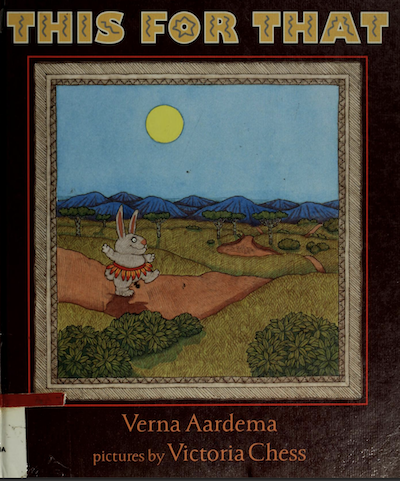Carrying on with the stories from southern Africa this week, I have another book by Verna Aardema to share, but it's a book with offensive illustrations, so I am sharing it today to provide an example of what kinds of books are NOT good for sharing with children... and in this case, I'll be able to provide two totally different styles of illustrating the same story in order to make the point.
So, starting with the more recent book, the one with the terrible illustrations: This for That: A Tonga Tale, published in 1997. The text is by Verna Aardema, a prolific author of African folktale books for children, and the illustrations are by Victoria Chess, also a prolific illustrator:
Here's an example of what I mean by offensive images in the book:
I'm really shocked that a published in 1997 thought this was acceptable. At this point, Aardema was in her late 80s (she was born in 1911), and I'm guessing she had little or no involvement with the illustrations; it's hard for me to imagine that this is the way she would have wanted the story to be illustrated.
The review at Kirkus points out that the images are derogatory: "the portrayal of Africans borders on stereotypical, and the landscape is fairly flat and nondescript—derogating the origins of the material."
When I read the review of the book in Publishers Weekly, I was very disappointed to see that the review had nothing to say about these troubling images: "Chess using a tawny palette, crafts straw-yellow grasses, red-dirt roads and olive-green bushes, then tweaks her compositions with cagey details, such as giraffe-patterned tree trunks. She neatly frames the images in borders resembling woven reeds, and attires the guileful Rabbit in a clownish skirt of yellow-and-red feathers. As the action progresses, a golden sun sets to a red glow behind blue mountains, adding to this book's strong visual appeal."
Strong visual appeal? I don't think so... although you can take a look and decide for yourselves.
This same chain tale about Rabbit also appears in a book Aardema had published in 1973, Behind the Back of the Mountain, illustrated by the amazing artists Leo and Diane Dillon, also at Internet Archive. There is just one illustration for the story in that book (it's not a picture book for children, but instead a collection of stories written for older readers)... and it is breathtakingly beautiful, a total contrast to the racist cartoons in Chess's book:
Did Chess even look at this earlier illustration by the Dillons? Maybe if she had looked at this work of art it would have given her pause before she embarked on her own illustrations.
In addition, you can see the source that Aardema used for the story, a book of Bantu folklore published in 1921: Specimens of Bantu Folk-lore from Northern Rhodesia by J. Torrend, also available at Internet Archive:
Using the version printed in Torrend's book, you can see just what Aardema started with: My Berries! You can also see the Tonga version in the book, because Torrend's book includes the original, as well as his English translation, and he provides the name of the storyteller at the end: Ndime Ñanga, "I am Ñanga" (which is also the word for a traditional Bantu healer; there are other stories in the book narrated by this same storyteller).
So, in addition to sharing Torrend's book (which is an incredible resource), I hope that this post can serve as a caution about what can go WRONG when adapting traditional stories, and what a crucial role illustrations can play. Just as with the text, if the illustrations are done with no respect for the culture, then there's nothing "multicultural" about that book; it does more harm than good, reinforcing already narrow-minded stereotypes and assumptions.
Meanwhile, if you want to read a picture-book with an African chain tale written by Aardema and illustrated beautifully by the Dillons, take a look at Why Mosquitoes Buzz in People's Ears: A West African Tale. The Dillons were awarded a Caldecott Medal in 1976 for their beautiful illustrations to this book, and justifiably so! Their work here is the opposite of Chess's illustrations in every way.






No comments:
Post a Comment
Comments are limited to Google accounts. You can also email me at laurakgibbs@gmail.com or find me at Twitter, @OnlineCrsLady.